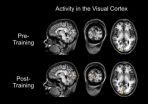(Press-News.org) Training human volunteers to control their own brain activity in precise areas of the brain can enhance fundamental aspects of their visual sensitivity, according to a new study. This non-invasive 'neurofeedback' approach could one day be used to improve brain function in patients with abnormal patterns of activity, for example stroke patients.
Researchers at the Wellcome Trust Centre for Neuroimaging at UCL used non-invasive, real-time brain imaging that enabled participants to watch their own brain activity on a screen, a technique known as neurofeedback. During the training phase, they were asked to try and increase activity in the area of the brain that processes visual information, the visual cortex, by imagining images and observing how their brains responded.
After the training phase, the participants' visual perception was tested using a new task that required them to detect very subtle changes in the contrast of an image. When they were asked to repeat this task whilst clamping brain activity in the visual cortex at high levels, they found that those who had successfully learned to control their brain activity could improve their ability to detect even very small changes in contrast.
This improved performance was only observed when participants were exercising control of their brain activity.
Lead author Dr Frank Scharnowski, who is now based at the University of Geneva, explains: "We've shown that we can train people to manipulate their own brain activity and improve their visual sensitivity, without surgery and without drugs."
In the past, researchers have used recordings of electrical activity in the brain to train people to get better at various tasks, including decreased reaction times, altered emotional responses and even enhanced musical performance. In this study, the researchers used functional magnetic resonance imaging (fMRI) to provide the volunteers with real-time feedback on brain activity. The advantage of this technique is that you can see exactly where in the brain the training is having an effect, so you can target the training to particular brain areas that are responsible for specific tasks.
"The next step is to test this approach in the clinic to see whether we can offer any benefit to patients, for example to stroke patients who may have problems with perception, even though there is no damage to their vision," adds Dr Scharnowski.
INFORMATION:
The study, funded by the Wellcome Trust, Swiss National Science Foundation and the European Union, is published online today in the Journal of Neuroscience.
Learning to control brain activity improves visual sensitivity
2012-12-05
ELSE PRESS RELEASES FROM THIS DATE:
Semen concentration and quality fell in French men between 1989 and 2005
2012-12-05
New research shows that the concentration of sperm in men's semen has been in steady decline between 1989 and 2005 in France. In addition, there has been a decrease in the number of normally formed sperm. The study is published online today (Wednesday) in Europe's leading reproductive medicine journal Human Reproduction [1].
The study is important because, with over 26,600 men involved, it is probably the largest studied sample in the world and although the results cannot be extrapolated to other countries, it does support other studies from elsewhere that show similar ...
Put the kettle on? When tea drinkers were viewed as irresponsible as whiskey drinkers
2012-12-05
Poor women who drank tea were viewed as irresponsible as whisky drinkers in early 19th-century Ireland, new research by Durham University has unearthed.
Critics at the time declared that the practice of tea drinking – viewed as a harmless pastime in most past and present societies – was contributing to the stifling of Ireland's economic growth, and was clearly presented as reckless and uncontrollable.
Women who drank tea wasted their time and money, it was said, drawing them away from their duty to care for their husbands and home. It was felt this traditionally female ...
More babies survive premature birth, but serious health problems unchanged
2012-12-05
Research published on bmj.com today suggests that although more babies survived shortly after extreme preterm birth in England in 2006 compared with 1995, the number with major conditions on leaving hospital remained largely unchanged.
A second study, also published today, shows some improvement in the number of extremely preterm children who survived without disability at 3 years of age, but no change in the rate of serious health and developmental problems over the same 10-year period.
Taken together, these two large studies (known as the EPICure studies) suggest ...
Gaps in life expectancy between rich and poor set to increase over next 10 years
2012-12-05
Health inequalities between England's richest and poorest areas have widened in the ten years between 1999 and 2008. Researchers warn, in a study published today on bmj.com, that over the next ten years, we may experience smaller increases in life expectancy than in the past decade and health inequalities may rise at an even faster rate.
Studies have shown that economic decline is associated with long term negative health impacts and the current climate has raised concerns about this. Between 1999 and 2008 the target (set by the government) for reducing the gap in life ...
First measurements made of key brain links
2012-12-05
PROVIDENCE, R.I. [Brown University] — Inside the brains of mice and men alike, a relatively big football-shaped region called the thalamus acts like a switchboard, providing the prefrontal cortex, the part that does abstract thinking and decision-making, with most of its information. The thalamus's responsibility even includes helping the prefrontal cortex to maintain consciousness and arousal.
Essential as this "thalamocortical" partnership is, neuroscientists have understood very little about the connections coming from a matrix of cells in the so-called "nonspecific ...
Protected 'power naps' prove helpful for doctors in training to fight fatigue
2012-12-05
PHILADELPHIA – New research from the Perelman School of Medicine at the University of Pennsylvania and the Philadelphia VA Medical Center indicates that the implementation of protected sleep periods for residents who are assigned to overnight shifts in a hospital represent a viable tool in preventing fatigue and alleviating the physiological and behavioral effects of sleep deprivation among these doctors in training. The new results will be published in the December 5th edition of the Journal of the American Medical Association (JAMA).
"Within the last two years, we've ...
New evidence on how compound found in red wine can help prevent cancer
2012-12-05
University of Leicester scientists will present groundbreaking new evidence about how a chemical found in red wine can help prevent cancer on Wednesday, December 5.
Experts from around the world are set to attend Resveratrol 2012, a major conference at the University which will assess the latest advances in the study of resveratrol – a compound found in the skins of red grapes.
The conference will feature new findings based on the last two years of research, which show how the chemical can help prevent cancer, heart disease and diabetes.
The event follows the first ...
Scientists find oldest dinosaur – or closest relative yet
2012-12-05
Researchers have discovered what may be the earliest dinosaur, a creature the size of a Labrador retriever, but with a five foot-long tail, that walked the Earth about 10 million years before more familiar dinosaurs like the small, swift-footed Eoraptor and Herrerasaurus.
The findings mean that the dinosaur lineage appeared 10 million to 15 million years earlier than fossils previously showed, originating in the Middle Triassic rather than in the Late Triassic period.
"If the newly named Nyasasaurus parringtoni is not the earliest dinosaur, then it is the closest relative ...
Hushed hoarders and prying pilferers
2012-12-05
VIDEO:
Eurasian jays change strategies to prevent others from stealing food and to improve their chances of absconding with other birds’ caches.
Click here for more information.
In order to prevent other birds from stealing the food they are storing for later, Eurasian jays, a type of corvid, minimizes any auditory hints a potential pilferer may use to steal their cache (food that is buried for later use). The new research was published today, 05 December, in the journal ...
Housing sales data used to estimate value of urban natural resources
2012-12-05
ST. PAUL, Minn., December 4, 2012 – Trees, water and lawn clearly matter to urban dwellers. For city planners balancing green space with other demands, the question has been just how much green space matters to residents.
Working with lead author Heather Sander of the University of Iowa, economist Robert Haight of the U.S. Forest Service's Northern Research Station estimated how much home buyers are willing to pay for more scenic vistas, better access to outdoor recreation, and greater neighborhood tree cover. Their study, "Estimating the economic value of cultural ecosystem ...



